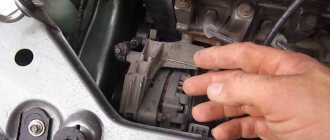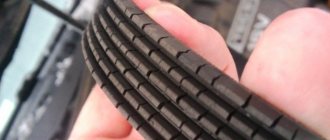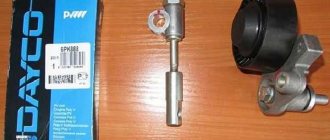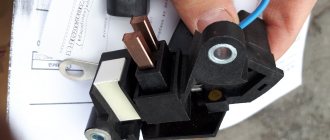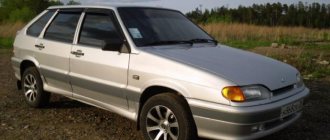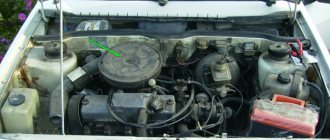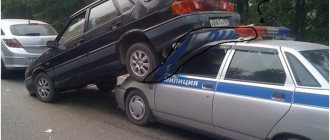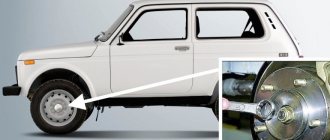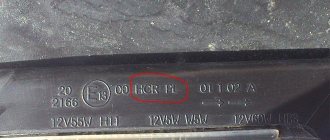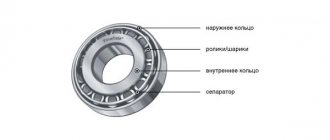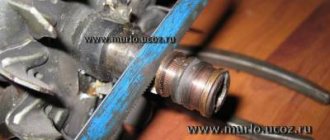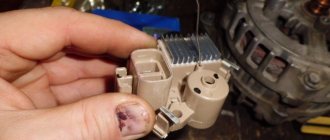04/13/2021 1,462 Generator
Author: Ivan Baranov
The design of the generator unit as a whole is quite complex - this mechanism consists of many elements, each of which performs a specific function. During operation, almost all component parts of the device are subject to wear; one of the elements that most often wears out is the generator bearing. You can learn more about the purpose and malfunctions of this part from this article.
[Hide]
Maintenance frequency of car generator bearings
When servicing the unit, you need to know which bearings are on the generator, and which race of each of them is pressed into place. To extend the time between overhauls, bearings are lubricated at the time of installation at the factory or when replaced by the user. It is believed that this amount is sufficient for the entire life of the rolling elements.
The frequency of bearing replacement is determined by ear:
- if the generator is noisy, it means the clip has worn out;
- Before jamming, the generator bearing hums for quite a long time, so the owner usually has enough time not to let this happen.
Bearing wear
Attention: It is usually difficult to determine by ear which of the two bearings has become unusable, so the rolling elements are replaced as a set - front and rear.
Design features of the generator are:
- one bearing is called the front bearing, since it is pressed into the corresponding (front) generator cover by the outer race;
- the second one is put on the shaft with tension on the reverse side, called the rear one, and is located near the commutator group;
- Before changing standard rolling consumables, you need to prepare a special tool;
- To get to the rolling parts, you will first have to remove the generator and then completely disassemble it.
Generator front bearing
Generator rear bearing
For example, the front bearing can be knocked out, then a new rolling element can be installed in the mounting hole without a puller. It is important that the external dimensions match. It will not be possible to pull the rear bearing off the shaft in this way; a puller will be required. But you can put on a new standard product by tapping a hammer on a sleeve of a suitable size or an old bearing.
Bearings for hydro, wind and heat generators
The largest synchronous hydroelectric generators convert renewable energy from falling water into electrical current. The diameter of the rotor of an energy-producing installation can reach several meters, and its weight can reach several tons. Such huge parts rotate on special thrust plain bearings - thrust bearings of a spring-disc or segment design. To ensure rotation with such a load, these bearings are made of special heavy-duty metals or composite copolymers and are equipped with a forced oil supply system. To prevent overheating, the lubricant has its own cooling system.
At least three types of bearings are involved in the design of wind generators, which perceive the rotation of the blades, the main shaft and the rotation of the housing (yaw). The main shaft bearing is directly connected to the generator. Is it a radial roller/sleeve bearing (depending on the size of the installation) that requires maintenance or not. In modern wind generators, the main shaft often rotates on a single/double-row cylindrical/spherical roller bearing. Steam generators at nuclear and thermal power plants use steam pressure released due to the decay of radioactive elements or the combustion of solid fuel (coal, peat) for rotation. Modern heat generators are often combined into one complex unit with steam turbines (turbogenerator), and the rotor rotates on two/four roller or plain bearings, depending on the size. Here, bearings require maximum reliability in conditions of high temperature and humidity. They are equipped with electrical insulation, forced lubrication systems, hydraulic lifting of the rotor, and sometimes equipped with an oil storage tank. Thus, generators have different designs, sizes, and use different standard or special bearings.
Replacing bearings yourself
If the generator is repaired on its own, the main problems become:
- how to remove the front bearing of a generator - it is often rolled into the front cover housing, pressing in a new product becomes more difficult, since part of the housing is destroyed during dismantling;
- Removing the rear bearing - you need a puller with suitable dimensions.
However, if the generator starts to hum, you need to act quickly before the rotor completely jams.
Dismantling the generator
On some cars, the generator can be removed through the hood, on others, for example, VAZ 2112, you will need an overpass, pit or lift. The dismantling sequence is as follows:
- disconnecting the “–” terminal from the battery;
- loosening the tensioner nut;
- dismantling the alternator belt;
- disconnecting the terminals of the on-board system from the dismantled unit;
- removing engine protection;
- unscrewing the two mounting bolts from below;
- removing the generator from below.
Dismantling the generator step by step
After this, the repair continues on a table or in a vice. At this stage, the dimensions of the front and rear bearings of the auto generator are still unknown to the user if there is no manual.
Complete disassembly
Since the generator bearing can be checked for runout only after complete disassembly, it is necessary to follow the following sequence of actions:
- marking - using a marker, paint or colored nail polish to mark the relative positions of the casing, front cover and body;
Marking the relative position of body elements
- dismantling the pulley - the rotor is carefully blocked with a screwdriver from turning, the pulley is turned away with a key;
Pulley removal
- removing the casing - it is usually fixed with latches that need to be unscrewed with a screwdriver to remove the specified part;
Removing the casing
- dismantling the front cover - use a screwdriver to unscrew the screws.
Removing the Front Cover
Under the casing there is a voltage regulator, a diode bridge, brush clamps, and a capacitor. Before replacing the bearing, you should check the wear of the brushes, the performance of the diode bridge and the voltage relay in order to increase the next overhaul period.
Attention: The armature (rotor) is removed from the stator winding with the rear bearing mounted on the shaft, while the front one remains inside the corresponding cover.
Before replacing standard consumables, it is necessary to check the bearings:
- rear - use your fingers to turn the outer race, which should not emit any extraneous sounds when rotating and have no play;
- front - here, on the contrary, the inner race is rotated and the play is controlled when the bearing is rocked inside the seat with your fingers.
Manufacturers unanimously recommend replacing the front cover along with the bearing, especially if it is rolled inside the seat. In practice, to reduce the repair budget, the cover is left for further use, since it costs 150–300 rubles.
Front bearing
If the results of the previous test require replacement of the alternator front bearing, the old standard product is removed from the front cover:
- the bearing can be knocked out inside by placing the cover on the bricks with the outer side up;
- or secure the lid in a vice;
- or use a special puller.
Removing the front bearing
In the presence of rolling, this fixing element is broken irrevocably.
Broken rolling
After the owner has removed the worn-out consumable, a new bearing is mounted inside the front cover:
- the lid is turned over with the inside facing up;
- the seating surface is treated with sealant;
- a sleeve of suitable diameter is installed on the outer race;
- With light blows, drive the bearing into the seat until it stops;
- lubricate the balls between the races or fill the grease into special holes.
The bearing has been checked for runout and is ready for use; assembly is carried out in the reverse order.
Rear bearing
The rear generator bearing is replaced as follows:
- dismantling with your own hands - the jaws of the puller grip the outer race, and by rotating the central screw the bearing is pulled out of its seat;
- installation - the standard product is mounted on the shaft, a sleeve of a suitable diameter is installed on the inner race, after which its surface is tapped with a hammer.
Removing the rear bearing
Rear bearing installation
Then all that remains is to lubricate the bearing and check the runout and rotation of the outer race. The bearing is a closed type or with rubber seals and is already lubricated at the factory, which reduces repair time and its budget.
The main symptom of a bad bearing
A generator can fail for various reasons. If the bearings are to blame for the malfunction, then this is indicated by a whistle under the hood.
As a rule, a worn bearing “whistles”. That is, it is not completely out of order, but it is working at half capacity, and soon it is expected to be completely defective. Charging may also not be lost, but there is a high risk of the generator jamming. Obviously, such bearings should be replaced.
Article on the topic: Smart key keyless entry and door unlocking system
New bearing
Specialists can easily determine whether a generator bearing is faulty by listening to the noise on the removed unit using a special device.
Bearing sizes and manufacturers
Before replacing a bearing with a new standard product, you need to buy it. The marking of these standard consumables is complex; the numbers in it are deciphered using special tables. Moreover, bearing designations according to GOST 3189 do not coincide with the markings of foreign manufacturers, so the user needs to know the following nuances:
- the marking consists of three parts (main, left, right), and blocks inside them;
- in the left and main parts the blocks are located from right to left, and in the right block on the contrary, from left to right;
- in cars, the front bearing of the generator most often has the designation of the main part 302 or 303, and the rear bearing 202 or 203;
- usually radial ball modifications with code 0 (0302 or 0202) or angular contact balls with code 6 (6303 and 6203) are used;
- therefore, for the specified parameters, you can decipher the dimensions using the table below;
- For foreign-made bearings, similar markings are used.
Marking of bearings according to GOST 3189
Table for deciphering bearing sizes by marking
Designation of imported bearings
The suffix (right side of the marking) of imported bearings contains additional information. For example, letters and numbers can represent:
- 2RS and RS – double-sided and single-sided rubber seals, respectively;
- N and NR – groove on the outer ring without a latch and with a latch, respectively;
- J – steel holder;
- Z – sheet protection on one side without seals.
The main problem for a car enthusiast when doing self-repair is the variety of bearing sizes inside the generator:
- it is difficult to guess the markings before disassembling, when the car is still running;
- after dismantling and disassembling the generator, the dimensions and markings are known to the owner, but he has to go to the store in a different car;
- in some stores, sellers practice a convenient system - the car owner takes 4 bearings 202, 203, 302 and 303, and returns two of them back.
These modifications have dimensions:
| Marking | External diameter (mm) | Inner diameter (mm) | Clip thickness (mm) |
| 6202 | 35 | 15 | 11 |
| 6203 | 40 | 17 | 12 |
| 6302 | 42 | 15 | 13 |
| 6303 | 47 | 17 | 14 |
In view of the variety of brands and brands of cars, different power and design of generators, it is easier to study the manual before replacing bearings. In it, the marking of these standard parts and adequate replacement options are mandatory.
The most expensive bearings are considered to be from the manufacturer FAG - 450 rubles (6303 modification) and SNR - 400 rubles (6203 ZZ). Bearings from Koyo are half cheaper - 200 rubles for 6303С3, NTN - 180 rubles for 6203ZZ and Nachi - 150 rubles for 6203ZZ. A set of standard products for the KZATE generator on the VAZ 2114 (16 V) from the Chinese manufacturer C&U costs 1,100 rubles. By default, this generator is equipped with Chinese consumables SKF 6202 and SKF 6303 (both with the suffix 2RS) at the factory.
In the old VAZ 2110, the generator was equipped with bearings 302 and 202 2RS; the new ones use a generator with a different shaft; standard products 303 and 203 are required, respectively.
Bearings for fuel generators and power plants
Independent fuel power plants of the installation convert the thermal energy of combustion into direct or alternating electric current of the required voltage from 12 to 400 V and a power of up to 1500 kW. Such generators are used for household (220 V), industrial and construction and repair purposes. Essentially, the generators of these devices have the same rotor design as automobile ones: the voltage, power and frequency at the output are determined by the speed of rotation, the stator coil and its size. The rotor is also supported by two sealed radial ball bearings, the outer diameter of which can reach 150 mm.
Pullers for standard parts
It is enough to simply knock the front bearing out of the cover with a hammer, even if there is a flange, so in 99% of cases only a puller for the rear bearings of the generator of two types is used:
- with two legs;
- with three legs;
Two-jaw puller
Three-jaw puller
Moreover, the device can be made independently; the most popular are two designs:
- the lower part of the split bushing is put on the outer race of the bearing, a bolt passes through the upper part, the halves of the bushing are pulled together by a tubular casing, a cover made of thick-walled metal is put on the bolt under the nut;
- in a square pipe, cuts are made from below, into which, after being placed on the outer race of the bearing, steel plates are inserted; a nut is welded to the top of the pipe, into which a bolt of sufficient length is screwed.
Split bushing puller
Square tube puller
With homemade devices, replacing a generator bearing is both faster and cheaper. However, they will take some time to produce.
What types of bearings are in the top ten: part numbers and sizes
Bearings in generators of VAZ 2110 cars are closed type, ball, single row, have a double-sided seal.
- The front marking is 6202 2RS (in domestic catalogs under number 180202).
- Rear bearing - 6103 2RS (aka - 24940220).
An important point: when choosing bearings, you should pay special attention to the manufacturers of their hubs. Typically, VAZ 2110 bearing hubs are produced in Samara, their marking is SP3-4.
You can also find hubs on the market from 23 GPP (this is Vologda) and 3 GPP (this is Saratov). It is strictly not recommended to buy bearings on which the hubs are not marked. You also cannot buy Chinese generator bearings, which are now found everywhere, since the quality of these bearings does not stand up to criticism.
